#statue of gautama buddha
Explore tagged Tumblr posts
Text
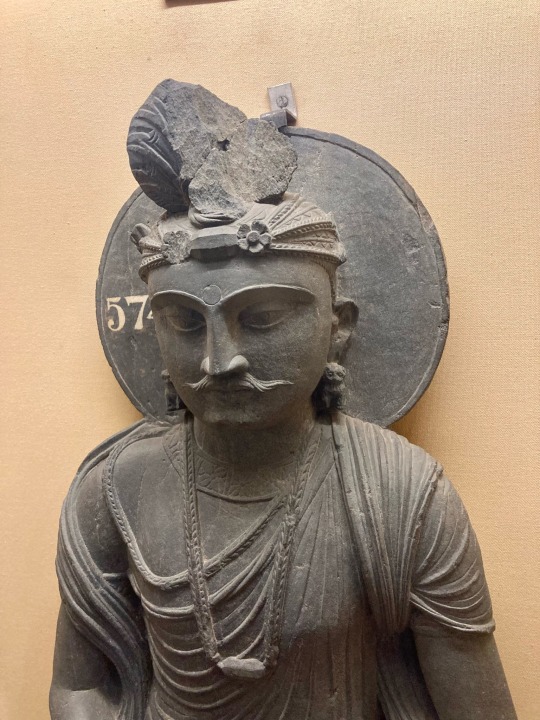
6 notes
·
View notes
Photo
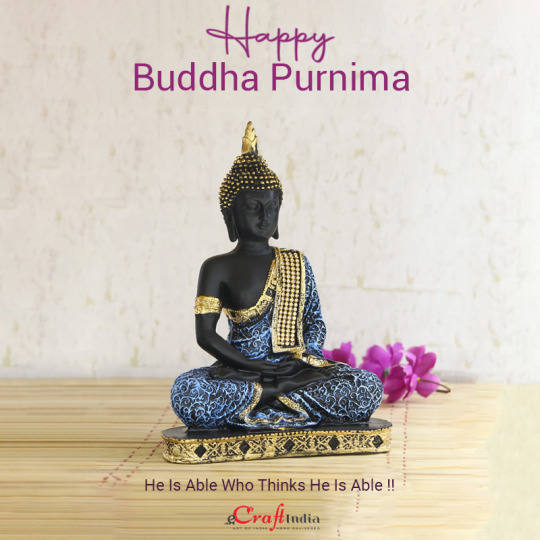
May Lord Buddha enlighten all our paths with love, peace & truth always. So, let us always pray for peace & harmony! Team eCraftIndia wishes you all a very Happy Buddha Purnima!
#Gifts#Celebrations#Happy Buddha Purnima#Buddha Purnima#Lord Buddha#Buddhas Birthday#Buddha Jayanti#Buddha Day#Buddhist Festival#Siddhartha Gautama#Gautama Buddha#Buddhism#Vesak#Festival#Culture#Buddha#Buddha Statue#Buddha Temple#Buddha Teachings
2 notes
·
View notes
Video
youtube
कहानी - महात्मा बुद्ध | आनंद त्याग में है | Buddha Wani | Story of Gauta...
#youtube#mahatma budh#Story of mahatma budh#motivation#motivational stories#motivational status#goutam budh#कहानी - महात्म�� बुद्ध#आनंद त्याग में है#Buddha Wani#story of gautama buddha#Hindi Motivational poem#Moral Stories#short poem about life#short story of mahatma budh#story
0 notes
Text

Buddha Pack Photorealistic Low Poly PBR Models - 4 Buddhas 3D Model Collection
#sculpture#statue#art#museum#religion#architecture#figure#ancient#buddha#sale#gautama#mystic#spiritual#scanned#room#people#god#monument#character#man
0 notes
Text
Toman and Buddhism + Tenjiku and Taoism
Another post to cover references in Tokyo Revengers!
This time, I'll be covering the links to two religions to be found in two gangs in the series, reference by reference, with the according explanation of each.
Some of these may be already known, I know one of them sure is (the whole buddhist manji confusion thing yeah yeah) but still, for the sake of a tidy compilation and of providing more detail, I'll go through them too. Some others are a lot less noticed, like Tenjiku's lean towards Tao, so it'll be best to lay down eeeeeeverything I've caught during my time enjoying this series. Plus, I'm pretty excited to get some of those less-known facts out here!!
Warning though, it's lengthy.
Let's start with Tokyo Manji Gang:
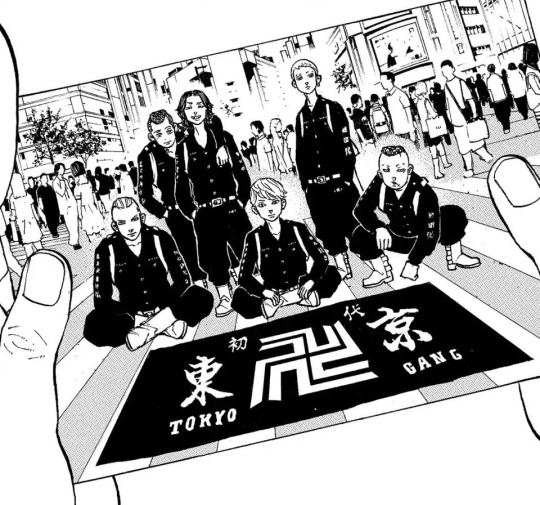
- Firstly, the gang's name and how it's written.
Despite Mikey suggesting the name as a short form of Tokyo Manjiro Gang, putting himself front and center, the kanji that ended up forming the name of Tokyo Manji Gang show that it went in a different direction of meaning. The manji used for the middle part ended up not being the same one from the name Manjiro, but a manji written as 卍. Aloud it's read the same way (many, many, many kanji are homophones), but has a different meaning.
卍 (manji) is an extremely common buddhist symbol (not even limited to japanese buddhism, but in hinduism and other aligned east-asian religions too), which represents the path of Buddha and the endless cycle of rebirth through samsara; the pursuit of leading a more spiritually balanced existence until the soul can reach enlightenment. In other words, it's nothing but deeply buddhist.
(To answer a common question around it: can it be called a swastika? Yes. The symbol in general, with each of the million variations that have popped up in different cultures, can be called a swastika as a broad term. There are a fuckton of swastikas. They mean a fuckton of different things. The tilt and the direction in which this one "spins" makes it different from other swastikas though, and it's always best to be precise and call this one manji.)
Moving on,
- Reunion spot.
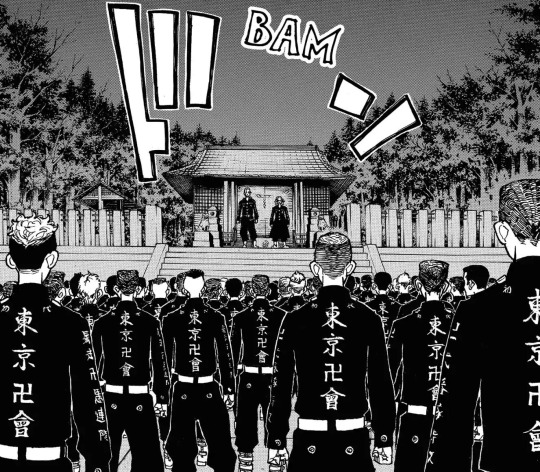

The Musashi Shrine (based, but not exactly taken from any of the real-life shrines and temples of similar name in Tokyo, as far as I know) is a shinto-buddhist temple. And, apparently, a place where the founders hung out from time to time, but I'll add to that later!!
It's cute to me that the Toman members seem to use the temple very respectfully. They always meet in it at night waaay after it's closed (daytime meetings have always taken place in different locations, never the temple during visiting hours), they've never once set foot even near the oratory/sanctum/other buildings, never been seen bringing the motorcycles anywhere they shouldn't, and the one time a character was seen using the public temizuya (the little stone fountain where visitors purify their hands and mouth), he was proper about it in terms of pouring water into his hand to rinse his mouth with, not getting the ladle or the rest of the water dirty, as one should always do.
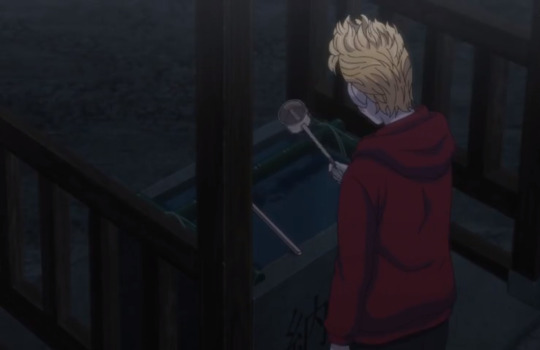
A fun fact: in Google Maps, buddhist temples are marked with the manji symbol!
- Gang's manifesto.

Embroidered on the chest of the gang uniform, you can see the text 天上天下唯我独尊 ("Above the earth and below the heavens, I alone shall be honored"), which is the gang's manifesto or motto. Sounds just like something Mikey would choose, yeah.
That phrase is also of buddhist origin; famously, the words spoken by Buddha Gautama Siddharta (bear in mind that buddhism isn't a religion with one god or anything like that, anyone enlightened can become a Buddha and many figures have been granted that status, but Gautama is the first and main one, the creator of the doctrine) when he was born. To be honest, this is very much interpretative, but I've come to get the impression that it's not so much a power or ego statement, but rather an expression of cultivating and honoring yourself…? It's absolutely up to personal reading and I'm absolutely not an expert. But those are certainly THE Buddha's words.
- Ceremonial sash.
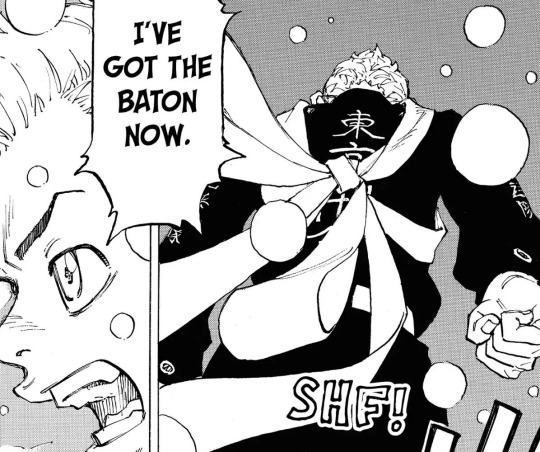
Another part of their uniform that bears a slight reference: the sash worn by the commander, vice-commander, captains and vice-captains during important fights.
These are tasuki, sashes originally worn by shinto-buddhist priests during ceremonies, in order to keep long sleeves and such in place. However, eventually, they also began being worn by samurai and all sorts of warriors, 'cause of their convenience. In modern times, they even started being used by just about anybody who wears traditional clothing but also does manual work and needs the sleeves out of the way. So it can be concluded that, over time, they stopped being strongly linked to religious practicers. In fact, even biker gangs in general ended up adopting the use of tasuki! Not for their religious origins, but for the warrior part; a bōsōzoku gang member wearing one would look very prepared and determined for a fight.
That's why overall, Tokyo Manji Gang having them is only a relative reference; they could be paying homage to their reference religion, as they could be only honoring gang traditions.
- Additional notes about the leader.
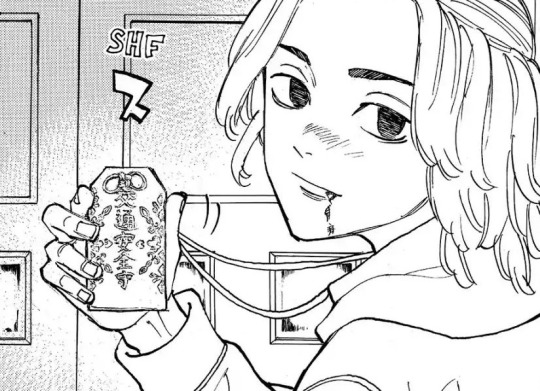
I feel it's important to add up all these little factors of Mikey's choosing, with other little details about him as a person that kinda make it all make sense.
If I say "Mikey seems to be religious, to an extent", I understand this can carry a bunch of tricky connotations. Japanese religion isn't exercised the same way it is in other places, someone being religious SURE AS HECK doesn't mean the same things it means in the christian west. Shinto-buddhism is so commonplace in Japan, most people partake in all kinds of religious practices without even thinking of them as strictly religious, such as new year's celebrations, casual prayer during shrine visits, purchasing and giving charms and such. Religion is integrated in life in a lot of extremely chill ways.
And we can observe a lot of things about Mikey that put him quite above the average in terms of his relationship with local tradition and religion. His house is a huge traditional-style family home, his family is hinted to be active in religious practice (remember Emma's appearances during the Christmas Showdown arc? How she mentioned that their family does a lot of temple visits, and even she considered it weird at that time of the year?), he's much more prone to wearing traditional clothing than his peers, his motif in extra clothing designs is the lion-dog (temple guardians; statues of these can often be found in them), his personal beliefs around death and relationship to the dead run deeper than others' to the point they find him disturbing when he talks about Shinichiro or Baji still being with him... many little things that aren't that deep on their own, of course, but when added up they paint a pretty coherent picture of the guy.
And so, it does make a lot of sense that, even from childhood, a temple was a regular place for Mikey to hang out with his friends, leading to the birth of Toman in one. And it makes a lot of sense that he made all those little choices about the way the gang would be styled. In my opinion, it's likely that those things just all came natural to him because they're a part of his background and worldview. Of course, how actively religious he is, how much he believes in the things he happens to know and how much exactly he might know about buddhism are all up to headcanoning and interpretation. Personally, I'm just a roleplayer that takes it as a relevant part of his character.
- Following a Buddha?
A little out-of-TR-universe element that I love to bring up, 'cause it's just hilarious and cool as hell, is the creation of this statue:
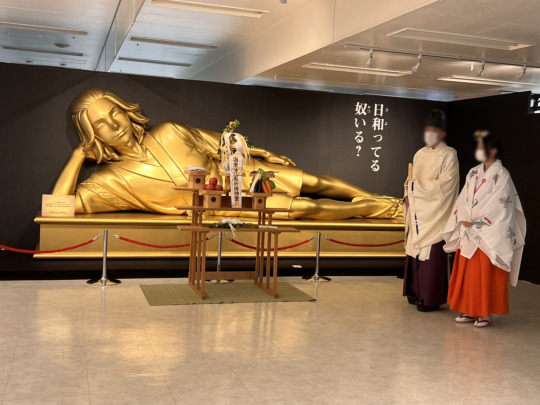
This part of the 2022 Tokyo Revengers exhibition straight up imitates the famous Reclining Buddha in the Wat Pho temple, Thailand.
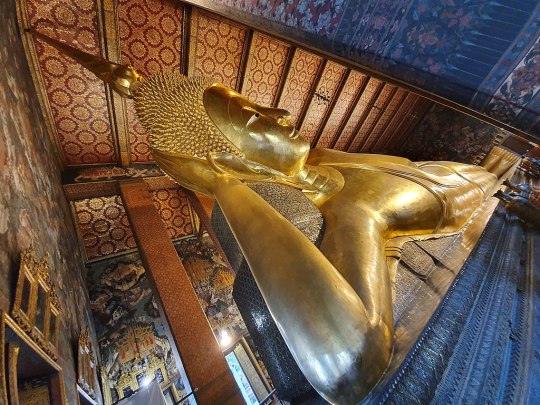
The ENORMOUS statue depicts the moment Buddha reaches nirvana, and his enlightened soul is at rest. The golden Mikey statue that imitates it very much intentionally likens him to a Buddha; funny to note that the exhibition staff even prayed to the statue, as you can read in the tweet itself.
What does this mean about Mikey's character? Well, this isn't within text in Tokyo Revengers, just a little outside factor, so I wouldn't take it too literally or too seriously, but it's interesting nonetheless. Personally, I see it as a hint that Mikey was supposed to be on his own little quest to enlightenment, or had the potential to be. Grappling with morality without having a natural sense of what's right, wrong, too much or enough is a major thing with his character. I can also imagine it might just be meant to represent the godlike view others have of him, the guidance they sought from him. Take it as you will!
The important thing is just that it exists, to confirm that there is an intentional connection of some type between the Buddha and Mikey.
Thaaaaat concludes the Toman and Buddhism section of this post.
Whew!! That was a whole lot.
The Tenjiku and Taoism section coming now is shorter, but I'm sure it contains interesting and less-known things (at least, I've never seen anybody talk about these)!
So let's see, Tao references in Tenjiku:

- Gang name.
Tenjiku is a now-obsolete word that translated directly to "heaven", while simultaneously being the japanese word for the country India (as taken from the chinese pronunciation, Tianzhu).
In modern times, it can be found mostly in ancient literature, the most prominent example being Journey to the West. Given that Kakucho and Izana mentioned this book and seemed to have knowledge of it as kids, we can conclude that's where they got the name of their gang from.
Why would they use the word for India to name their kingdom? What does this have to do with Tao? I'll get into that properly now:
- Kakucho, Izana & Journey to the West.

Journey to the West is one of the four great chinese classic novels (along with Romance of the Three Kingdoms, Outlaws of the Marsh, and Dream of the Red Chamber) which are enormous, ENORMOUS influences on east-asian literature and fiction in general. Journey to the West, itself, is considered the most popular east-asian literary work overall; of course, being super well-known in Japan, too. (To give my favorite funny example of just how omnipresent it is, y'know Dragon Ball? Hit anime series Dragon Ball? Unabashedly based on Journey to the West, which was to thank for most of its initial local popularity.)
It's the story of the buddhist monk Tang Sanzang, who travels to Tenjiku, to India, to that certain heavenly kingdom, to obtain sacred texts for Buddha Gautama Siddharta (the guy I described as THE Buddha in the Tokyo Manji Gang section above). The quest doubles as a search and exercise of enlightenment, as Tang Sanzang is aided by three protectors that are atoning for their sins and learning from him. The main guardian and arguably the true protagonist of the book is Sun Wukong, the Monkey King, a fighter "so strong he could carry a mountain on each shoulder, and still dash as fast as a meteor". It's a huge, epic, 100-chapter monster of a book, in which each chapter is already a fantastic and entertaining anecdote about the characters or what happens in their travels, but also a long spiritual journey that pretty much serves to subtly teach the principles of Tao (term that can be translated to "the path", chinese religion and philosophy).
A tangent: let me just show you how large it is (and why I haven't been able to finish it, 'cause I cannot take this brick of a book anywhere lmaoooo).
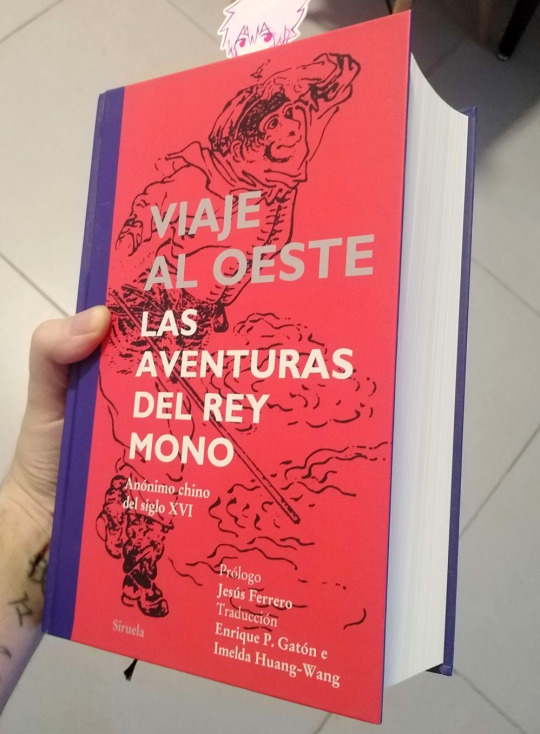
(Cover says Journey to the West: The Adventures of the Monkey King. It's in spanish.)
My guess is that Izana and Kakucho studied about it or read some chapters in school, 'cause dang, there's no way they read all of this at that age?!?! BUT ANYWAY.
While there's obviously quite some buddhist influence in the story, most of what it works with throughout is rooted in chinese folklore and Taoism. The edition of the book I have even begins with extensive notes and introductory explanations about Tao, as its themes of harmony with the universe, self-cultivation, internal alchemy, its main ethics and values, etc etc etc are the basis from which the book is built up. The characters very actively engage with Tao. Sun Wukong is an ardent student of Tao who obtains a bunch of powers through it, for one.
I've gone into this much into detail because Kakucho and Izana make it pretty explicit that, to them, Izana is like monk Tang Sanzang leading to Tenjiku, and Kakucho is like his guardian of unmatched strength, Sun Wukong.
In the end of Journey to the West, it's both Tang Sanzang and Sun Wukong that accomplish their goal and also obtain enlightenment, finally ascending to buddhahood. Had Izana and Kakucho's journey with Tenjiku reached their original destination (not "to become a criminal syndicate that controls Japan" but "to build a kingdom where everyone without a home could exist"), had it been like Tang Sanzang and Sun Wukong's pilgrimage… they would've learned true balance and they would've found the necessary enlightenment.
Again, I find this little connection with characters that could've been on a quest towards buddhahood, but as far as things went in the main TR timelines, all failed.
- Uniform & logo.
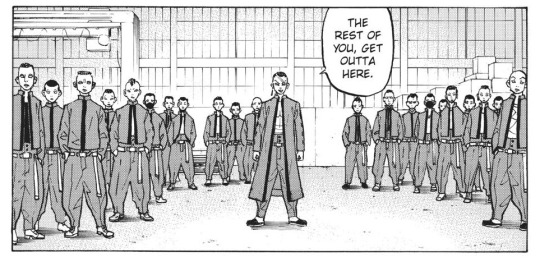
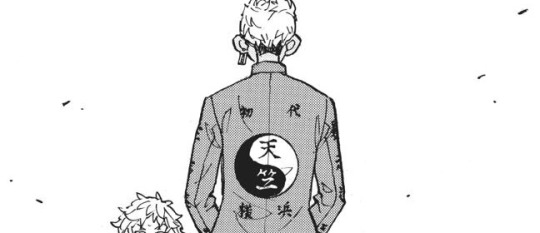
Finally, something lighter and quicker to add, haha.
There are symbols and references that are so so so widespread that they become more of an aesthetic detail than a symbol with meaning, in the eyes of the general public. The yin-yang is one of those symbols that just… appears in a lot of places, fashionably, and one kinda gets used to seeing it without thinking much about it. Sometimes it's not meant to stand for much more than a decorative detail, yes, that definitely happens, but sometimes it's very much a thoughtful choice. With Tenjiku, given its connection to Taoism, I'm gonna treat the yin-yang as a meaningful choice.
So! On the back of the uniform we have a yin-yang, Taoist symbol that represents the balance of the two complementary and opposing forces of the universe (note: it's not a good vs evil type of thing, as tends to happen with western black-white dualism, but rather… the fact that reality needs to be composed of push and pull to get anywhere, hard and soft things with their own function, sun and shade. A common comparison is how a mountain will have a sunny side and a shady side when looked at in a certain moment, but the sun and shade will switch over at another time of day, in a needed cycle). Other features of the uniform are a mao collar instead of a more common style for gang jackets, and an intense red color, the main auspicious and prosperous color in chinese culture. These last two little features could easily be coincidental, but when paired with the yin-yang, I feel like it's intended to lean towards chinese aesthetics.
And with that,
I end this reference post!
Did you learn anything you didn't know? Did you enjoy learning it? Any thoughts? I LOVE TO TALK ABOUT THESE THINGS, SO FEEL FREE TO DROP BY MY ASKBOX with any comments or questions or such!!
#tokyo revengers#tokyo revengers meta#tokyo manji gang#toman#tenjiku#kurokawa izana#sano manjiro#izana kurokawa#manjiro sano#mikey#kakucho#thoughts and talk and so#tokyo rev#wanted to write this one forever#just never quite got around to it
194 notes
·
View notes
Text
➠ Symbolism of Yuuji’s childhood memories in Chapter 265 and how it connects to his conversation with Sukuna:
I was rereading the latest chapter and ended up dwelling on how the order in which certain things appear along the path Yuuji and Sukuna are walking connects with the progression of their conversation and the outcome of it, so I want to point out a few of such details in case someone else finds it interesting.
First, I will start with Morning Glory (asagao, 朝顔, lit. morning face) Yuuji mistakes Ajisai for. Asagao was brought to Japan with the advent of Buddhism and came to represent Enlightenment. When one thinks of the flower, an old line often comes to mind: [Asagao blossoms and fades quickly to prepare for tomorrow’s glory]. It is the theme of one of the oldest songs on the morning glory, written by the Chinese priest at the temple of Obaku near Uji, who is said to have been the first person to introduce the flower to Japan. Since its arrival, it has been a frequent theme in Japanese Buddhist poetry, particularly when writing on the fleeting condition of human lives, as the poets found a congenial subject in the morning glory, for they considered no flower has a briefer life and beauty, and the buds of yesterday are flowers to-day, but only for a few short hours, and then nothing will be left but ruin and decay; though how quickly fresh buds will appear and fresh flowers open to be the tomorrow’s ‘morning glory’. Therefore, in Japanese culture, asagao is a symbol of new beginnings. The flowers open in the morning, representing the dawn of a new day, and close in the evening, symbolising the end of the day and the passing of time.
Next comes Ajisai (紫陽花), the Japanese hydrangea. The flower has both positive and negative connotations in Japanese tradition, symbolising both deep or heartfelt emotion and also a fickle or changeable heart. However, I mentioned in this post that the blue hydrangea (I am assuming blue, because Yuuji mistook it for asagao) can mean sincerity, forgiveness, remorse and spirituality. Ajisai are also an important part of the ceremony in celebration of Buddha’s birthday (Kambutsue), where his statue is washed with sweet hydrangea tea by the visitors of the temples. As such they are often found at shrines and temples.
After that, Yuuji and Sukuna catch Crayfish. Interestingly, Buddhist philosophy references the crayfish when speaking about the temporary nature of existence. All that seems solid and permanent, like the crayfish shell, eventually disappears. There is a famous painting of Priest Xianzi (Japanese: Kensu) by Unkoku Tōgan from the Momoyama period. It depicts a seated figure of a Buddhist monk who appears to be contemplating the large crayfish (or shrimp). Kensu or Xianzi is a semi-legendary eccentric priest of the Tang dynasty, who spent much of his time wandering along riverbanks, eating crayfish and clams. He allegedly achieved Enlightenment while catching a crayfish.
Later they come across Horses, which hold a special place in Buddhism, embodying spiritual virtues and the timeless quest for Enlightenment. The story of Siddharta Gautama Buddha’s renunciation and his separation from his beloved horse, Kanthaka, is a significant story in Buddhism. As Siddharta decided to leave behind his life of luxury and embark on a spiritual journey, he faced the task of saying goodbye to his beloved horse. The separation from Kanthaka symbolises the profound sacrifice he took when he renounced worldly attachments in the pursuit of Enlightenment. Additionally, in the Shamanistic tradition of East Asia and Central Asia, there is a concept of the Wind Horse, a flying horse that is the symbol of the human soul. In Tibetan Buddhism, it was included as the pivotal element in the centre of the four animals symbolising the cardinal directions.
After the horses, we see them engage in Archery. As a Buddhist symbol, the bow and arrow are found throughout the art, mythology and theology; held by gods, part of vivid legends, lauded in sacred texts and painted on the walls of the temple fortresses. They are symbols of the wisdom and compassion of the Buddha. Just as the arrow flies straight to its target, so too must the mind of the archer be focused and free from distractions.
And lastly, Snow. As a symbol of purity, it is taken as representative of naive innocence behind heroic undertakings. In this regard, it is also a subject of paintings in special combination with cherry blossoms as a symbol of what is ephemeral and transitional as is the life of the hero. However, snow is often associated in the Japanese short poetry with the Zen notion of Emptiness. This is because, to quote the poet Naitō Jōsō, snow covers and clears everything: [fields and mountains / all taken by snow / nothing remains]. From the lens of Buddhism, as the defilements—greed, hatred, and delusion—melt away like snow, the process of purification speeds up our relinquishment of impurity. To do this, one needs to be able to feel their humanity from within, where the invisible factors of mindfulness, clarity, faith, energy, concentration, and wisdom can dismantle and dissolve years of deluded ways of perception, of relating to life. Only then will the ground of awakening begin to appear.
I find Yuuji’s conversation with Sukuna to be rich in symbolism, each element along their path reflecting deeper themes of compassion and Enlightenment. Their journey begins with the morning glory, symbolising a new beginning and Yuuji’s offer of redemption to Sukuna. The hydrangeas, mistakenly identified as morning glories by him, signify Yuuji’s readiness and offer of remorse as he sincerely reminisces on his childhood with him. The appearance of the crayfish continues this theme, highlighting that this conversation is a chance for Sukuna to contemplate the temporary nature of existence and the path he wants to continue leading from there on. The horses, embodying spiritual virtues and the timeless quest for Enlightenment, appear as Yuuji’s way of asking him to renounce his old ways in pursuit of Enlightenment, followed by Archery right after, emphasising his readiness for compassion despite all Sukuna has done to him, mirroring the Buddhist ideal of a concentrated, undistracted mind. And lastly, comes snow as a symbol of purity and the potential for redemption, evoking the Zen notion of emptiness and the purification of defilements. Yuuji, by invoking these symbols, offers Sukuna the last chance at redemption and Enlightenment. He shows Sukuna the final act of compassion if Sukuna shows remorse, which Sukuna refuses.
In the end, Yuuji and Sukuna walk the same path, but their choices lead them in opposite directions. Yuuji embraces the symbols of Enlightenment, striving for a higher understanding and compassion, whereas Sukuna rejects these ideals, choosing instead to renounce the path to Enlightenment.
#i need to stop info dumping hereㅋㅎ#but i have so many thoughts on the last two chaptersㅜㅜ#hopefully someone finds this interesting.#jjk spoilers#jujutsu kaisen spoilers#jjk#jujutsu kaisen#itadori yuuji#yuji itadori#sukuna#ryomen sukuna
79 notes
·
View notes
Text
another little snippet from my cutesy, fluffy satosugu fic <3
Satoru comically scooted himself down the length of the bench until he was resting his head on Suguru’s thigh. “Play with my hair while I nap,” he requested in a murmur.
Suguru laughed, shooting an incredulous look at his friend. “Are you joking?” Satoru peered up at Suguru over his sunglasses. Oh, no, he’s serious. Suguru started, carefully, “Satoru… isn’t that a little-”
“What, best friends can’t play with each other’s hair?” Satoru defended, a small flush spreading across his cheeks, “We clearly need some rest and we’ve got time to kill before we ride back.”
Satoru flashed his big, blue, puppy-dog eyes, not that Suguru needed much convincing anyway, and Suguru sighed. “Fine, fine. Such a princess…” he muttered. He gingerly threaded his fingers into Satoru’s fluffy, snowy white hair, so soft and thick.
Satoru was immediately transported back to his childhood when his many nannies would stroke his hair to coax him to sleep. It was so soothing and nostalgic to feel Suguru pet his head like this. “Just gimme like… fifteen minutes, okay?” He said with a hum, eyes closing contentedly as Suguru’s fingers grazed his scalp. Satoru was out in a matter of minutes, easily slipping into slumber on his trusted friend’s lap.
Suguru could have easily spent hours like this, spending an equal amount of time watching Satoru sleep peacefully and admiring the vast temple they were in. As he mindlessly stroked, he finally had a chance to take a good look around. Even with the rubble and destruction, it was gorgeous. The walls stretched on and on, accented with rich reds and glinting gold murals of Siddhartha Gautama and his journey to enlightenment. Miraculously, the giant, gold Buddha statue still stood tall behind the collapsed wall. He closed his eyes, focusing on steadying his breath and nothing else in the world besides his hand in Satoru Gojo's hair.
Satoru finally stirred from his slumber nearly an hour later. Suguru was still in the same position as before, losing track of time as he meditated with his fingers in Satoru’s hair. Satoru let out a big yawn, sitting up and stretching. “Damn, I needed that. How long was I out?”
“An hour, I think.”
“An hour!? You could have woke me up! What the hell were you doing for an hour?”
Suguru shrugged, “Meditating.” Satoru gave him a deadpan expression. “Oh, I got rid of Ichiji, too. He thinks we’re taking the train home tonight,” he added, smirking. To avoid raising suspicion, Suguru called Ichiji not long after Satoru fell asleep to sweet-talk him into leaving. According to Suguru, they were going to “sight-see” in the area since the mission wrapped up so quickly and they’d take the train back to Tokyo tonight. Ichiji bought this lie immediately and reported back to the academy. Suguru’s curse manipulation technique always fell second to his ability to talk himself out of a situation, his charisma and charm its own jujutsu entirely.
Satoru laughed and smiled, “Nice! Now we have the whole day to chill.” He turned towards his teammate. “Alright, Suguru, it’s your turn.”
“Huh?”
Satoru patted his lap as he clarified, “I’m not greedy, I’ll return the favor.”
Suguru eyebrows knitted together. “I don’t really nap well, you know that.” Though he’d be lying if he said didn’t think about Satoru stroking his hair.
“Well, that’s because you’ve never had Satoru Gojo playing with your hair. C’mon, just lay down. If you fall asleep, awesome, and if you don’t, you still get to relax.”
Suguru smiled, conceding and resting his head on Satoru’s thigh. He blushed, his gaze resting on the temple ceiling. Were his daydreams of romantic moments, such as these, with Satoru Gojo finally coming to fruition? His shallow crush only deepened over the time they grew close, but never once did he expect it could be reciprocated.
At least, not until today.
“It sounds like you just want an excuse to play with my hair,” he teased.
“Well, you do have great hair, Suguru,” Satoru replied with a grin as he pulled the elastic from Suguru’s bun, allowing his charcoal hair to spill onto Satoru’s lap. “It’s getting long!” He pulled his fingers through to splay its full length.
Suguru’s eyes fluttered closed as he commented, “Thank you. I’m letting it grow out.” Satoru wasn’t lying, it was extremely soothing having Satoru run his fingers through his hair. He fell silent, a small smile spreading across his face.
It had been over a year of Satoru secretly longing to touch Suguru’s hair again. The time Suguru spent the night in his dorm, and his curiosity got the better of him, nearly changed his life. He couldn’t stop obsessing over it, his fingers itching every time he saw Suguru fix his bun. It was still so silky and beautiful as it fell through his fingers. For having such an excitable personality, he had a surprisingly gentle touch as he caressed Suguru’s locks.
“I admit, this is nice…” Suguru practically purred, sighing happily. He was definitely growing sleepy, allowing himself to let go and lean into the feeling of Satoru playing with his hair.
“See? Now go to sleep.”
Suguru did end up drifting off, but only for about thirty minutes. He awoke to two luminescent, ocean eyes staring right at him and jolted. “Jeez, Satoru, you scared the shit out of me.” He moved to sit up, but Satoru’s fingers were still tightly entwined in his hair.
“Oh, sorry,” Satoru replied sheepishly, flushing and looking away. He pulled his hand back quickly so his friend could get up.
Suguru stood and stretched his arms and back. He felt better, a lot better actually, his energy replenished. “I guess we can go, I can summon the- hey, where’s my hair tie?”
“Oh I lost it, sorry.”
He lied. It was in Satoru’s pocket.
Suguru squinted at him, giving him a scrutinizing look. “You’re lying.”
“Swear I’m not.” Satoru lifted his hands as if he was being interrogated by the police.
“Guess we need to call Ichiji, then…” Suguru started with a mock sad tone, pouting and grabbing his phone from his pocket. “It’s not safe to fly with hair in my face.” He opened the phone, his thumb over the call button.
Satoru groaned and rolled his eyes, shoving a hand in his pocket. “Oh, look at that, I found it. Oops, my bad,” he said sarcastically and flicked it over to Suguru.
Suguru rolled his eyes back, muttering “Idiot” under his breath, and quickly tied his hair up in a tight bun. He strolled outside of the temple to find an open space to summon his new curse and Satoru trailed along.
Thanks for reading! :-) Be sure to read the rest of the fic here:
#satosugu#stsg#gego#jjk#fanfiction#ao3#ao3 fanfic#gojo satoru#geto suguru#jujutsu kaisen#ao3 writer#ao3 link#archive of our own#fanfic writing#jjk fanfic
39 notes
·
View notes
Text
Unfortunately I have seen people make connections of Jesus and Buddha having similar features in statues but I think it's just the fault of the Greeks (well for the former, by proxy of Romans) who influenced how Jesus and Siddharta Gautama were depicted.
20 notes
·
View notes
Text
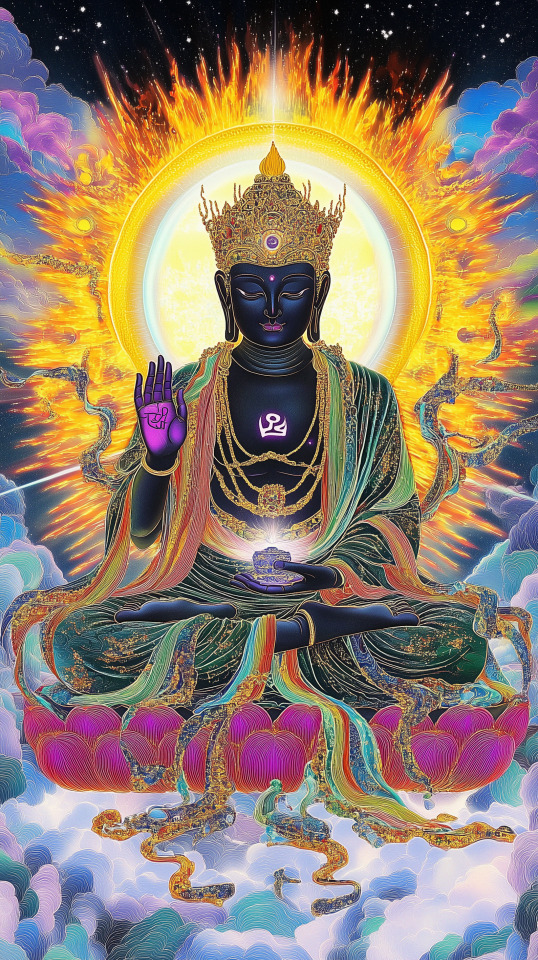
Maha Vairocana, Cosmic Sun Buddha Talon Abraxas
Vairocana is one of the Five Dhyani Buddhas created by Adhi Buddha. In Sanskrit, the name vairocana means "luminous" or "embodiment of light". In Chinese, Japanese, Tibetan, and Vietnamese Buddhism; Vairocana is called as Dari Rulai / Piluzhena Fo, Dainichi Nyorai, Nampar nangdze / Namnang, and Dai Nhat Nhu Lai respectively. In the above mentioned Buddhism, the Buddha is seen as the embodiment of Buddhist concept of Emptiness. While in Mahayana and Vajrayana Buddhism, Vairocana is considered as a Primordial Buddha and is located at the center. He is also referred to as the "great illuminating one," “the Life force that illuminates the universe," and importantly, "all-encompassing Buddha". Therefore, Vairocana is mentioned in different sutras.
In Brahma Net Sutra, it is written that Vairocana Buddha is seated on a top of a lotus pedestal and surrounding of that lotus there are thousands of flowers. These flowers are the Sakyamuni Buddhas, which supports a hundred million worlds. It is also mentioned that Sakyamuni Buddha is born in each world. They all attain Buddhahood at the same time under Bodhi tree. All these Sakyamuni Buddhas have Vairocana as their original body.
In Flower Garland Sutra, also called Avatamsaka, Vairocana is presented as the ground of being and the matrix from which all phenomena emerges. He is regarded as the Dharma Body of the historical Buddha (Siddhartha Gautama).
In Samantabhadra Meditation Sutra, also called as the "Sutra of Meditation on the Bodhisattva Universal Virtue", Vairocana is mentioned as a Buddha who has similar characteristics as that of Sakyamuni Buddha. And he roams around a place called "Always Tranquil Light".
Lotus Sutra, also called Saddharma Pundarika Sutra, is composed in the first century B.E.C. In this sutra, it is believed that Buddhas are said not to die even though their physical bodies degenerate. It is also mentioned that Buddha has explained that he has always lead the beings to their salvation and will always continue to do so. Therefore he is considered as the most sublime or truest reality in the universe.
In Mahavairocana Sutra, Vairocana is depicted as the universal Buddha from whom all other Buddha are originated. He is also represented as the source of enlightenment who helps others to be free from causes and conditions. It is also mentioned that Vairocana taught about the Dharma to Vajrasattva but it was incomprehensible to learn for them. That's why Vairocana provided esoteric techniques and rituals to help Vajrasattva to conceptualize the Dharma beyond verbal form. Therefore, Vairocana is also referred as a teacher, without whom there would have been no Buddhism, and also there would not have the path to enlightenment.
Even though Vairocana is mentioned in various Sutras, the doctrine of Vairocana Buddha is largely based on the teachings of the Mahavairocana Sutra. This Sutra is thought to be the earliest comprehensive manual of Buddhist tantra. It is believed that this Sutra is composed in the 7th Century.
Iconography
Vairocana Buddha is often depicted as seated in the lotus pedal which is supported by a pair of two great lions. Symbolically, it is represented that when the lions roar, all other remains silent and listens to him. Likewise, when one is spreading Buddha's teachings almost all others remains silent and listens to the Buddha's valuable teachings. When Vairocana Buddha is depicted as meditating, it is believed that the image of Vairocana helps to transform the delusion of ignorance into the wisdom preached by the Dharma. Similarly, when Gautama Buddha turned the wheel of Dharma, it illuminated the hearts of people which was darkened by ignorance.
When Vairocana Buddha is depicted in Buddha statues, he is also shown in Dharma chakra mudra. This mudra is formed when the thumb and index finger of both hands touch at their tips to form a circle. The left hand faces inward which covers the right hand which is facing outward and the hands are held against the chest. The remaining fingers of both hands remain extended.
Since Vairocana is believed to be the aggregate of all the Dhyani Buddhas. Therefore, He has the complexion of pure white since white produced when all the colors merge together. His symbol is the dharma wheel. When all Five Dhyani Buddhas are depicted together in a mandala, Vairocana is placed in the center. He is often shown larger than other Buddhas around him. He is Lord of Akanistha Ghanavyuha Pure land which existed in the center. His consort is White Tara and his Bija starts with Om. In Vajrayana Buddhism, it is believed that Vairocana Buddha helps to overcome ignorance and delusion when a person chants his mantra.
Vairocana Sadhana - Diamond Realm:
29 notes
·
View notes
Text
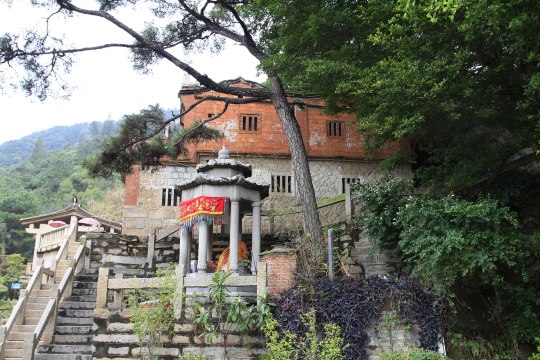


cao'an (thatched hermitage) and its manichaean remnants in jinjiang, fujian, china. though cao'an is on its surface not too different from other buddist temples, it was also manichaean, and may still be manichaean in secret. it's also one of the last standing historical manichaean places of worship in the world. this place has quite the history, so i placed it under a read more:
manichaeism is a former world religion of babylonian origin, reaching as far west as the roman empire and as far east as han china at its greatest extent. it combines elements of several other prominent religions and philosophies - the most notable factor of this is that it reveres founder mani as the final prophet in a line consisting of zoroaster, the gautama buddha, and jesus christ. it went mostly extinct due to persecution of followers throughout its multi-continent laity. manichaean places of worship were either entirely destroyed or appropriated in other parts of the world. it lasted much longer in china (until ming dynasty times) and still exists in some parts of fujian and zhejiang. these believers prefer to remain private about their current practice. what outsiders know about the religion is solely through historical records; because of its comparative longevity in china, many of those records come from there.
manichaeans tended to draw more from the religious/philosophical influences on manichaeism that were most familiar to them. (for example, while manichaeism in jerusalem may have looked more abrahamic, manichaeism in istakhr may have looked more zoroastrian.) in china, manichaeism assimilated to both buddhism and taoism; in the former case, much of it was adapted to be stylistically buddhist, and mani received the title of "buddha of light" and a life story resembling the gautama buddha's.
cao'an was constructed during the song dynasty era (specifically in the 960s), when persecution against manichaeans had been ongoing from emperor wuzong of tang's suppression of all foreign religions. (the same policies had affected zoroastrians, eastern syriac christians, and buddhists, but continued for manichaeans after.) at this time, many manichaean temples had buddhist or taoist affiliations, or disguised themselves as buddhist or taoist only. it became officially buddhist after manichaeism was banned in 1368. since abandoned, it was revived for explicit buddhist usage for a short period in the early 20th century. it's preserved as a cultural monument today.
cao'an has managed to preserve remnants of its manichaean affiliations. one is that, instead of a nianfo phrase usually seen in chinese buddhist temples, an inscription on a nearby stone dating to the 15th century reminded worshippers of "purity, light, power, and wisdom". this mantra is an adaption of manichaean cosmology in chinese manichaeism. the original stone was destroyed during the cultural revolution but the phrase was re-inscribed on another after. another is a statue that seems to portray the buddha, but is thought to actually portray mani. unlike other portrayals of the buddha, this one has long, straight hair which is worn down, different facial features and hand/head postures, and, at one point, facial hair. (this was filed off in the early 20th century by a buddhist monk to make him look more like the buddha.) it's also consistent with other portrayals of mani in chinese manichaean art.
#china#architecture#details#worship#manichaean#buddhist#shared space#my posts#'Are Manichaeans Ahl al-Kitāb' - the greatest thread in the history of Abbasid forums locked by Harun al-Rashid after 12239 pages of heate
39 notes
·
View notes
Text
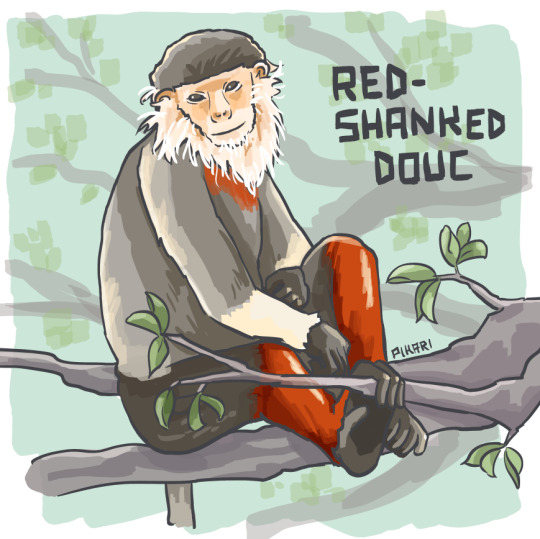
The past is already gone. The future is not yet here. Look deeply at life in the here and now. —Gautama Buddha
Red-Shanked Douc (Pygathrix nemaeus)
Laos, Vietnam, Cambodia
Status: Critically Endangered
Threats: illegal trade and hunting, habitat fragmentation
-----
Here's your monkey!! Thanks for getting me past 100 followers, and welcome to all new followers! 💚
I found these doucs the other day while looking at other species in Vietnam. These are officially my favorite monkey now!!* I am in love with their angelic faces. I feel like they must all be ascended buddhas with their childlike but ageless faces (even their behavior is peaceful compared to other species), so I looked for a buddha quote as the caption today.
I realized I want my blog to reflect this spirit. When thinking about endangered species, it can be too easy to despair about both the future and the past. But I just want to show the beauty** of what we have today.
(*I don't believe I had a favorite monkey before, but I do now.)
(**And that includes the weirdos!)
#which doesn't mean not to act today#but that we shouldn't project ourselves into anything but the present#as much as is possible#hopepunk#monkey#monkey art#primate#vietnam#laos#cambodia#asia#southeast asia
30 notes
·
View notes
Text

3 notes
·
View notes
Text
The Buddha in different religions/beliefs.
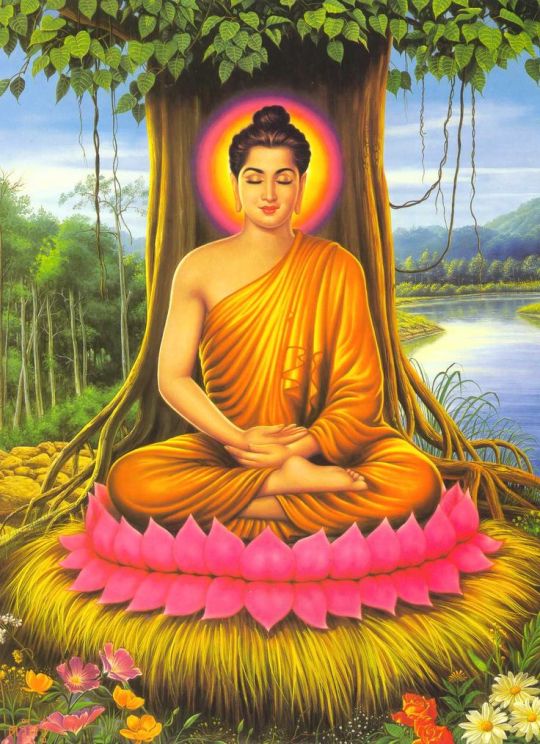
Firstly, who is the Buddha?:
The historical Buddha was a prince named Siddhartha Gautama who lived 2500 years ago in what is today northern India/Nepal. He was born into a warrior clan known as the Shakya, which is why he is often called Shakyamuni, “Sage of the Shakyas.” He is the one to later abandon worldly attachments, become enlightened, and found Buddhism.
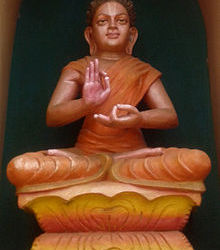
The Buddha in Hinduism.
Some Hindus consider the Buddha as the 9th avatar of Vishnu/Dashavatara, The Buddha was integrated into Vaishnavism, it was also believed the Buddha’s wife, Yasodhara, was the avatar of the wealth Goddess Lakshmi, though Buddhists deny this, so as other Hindus who identify the 9th avatar of Vishnu to another being who was also called “buddha”.
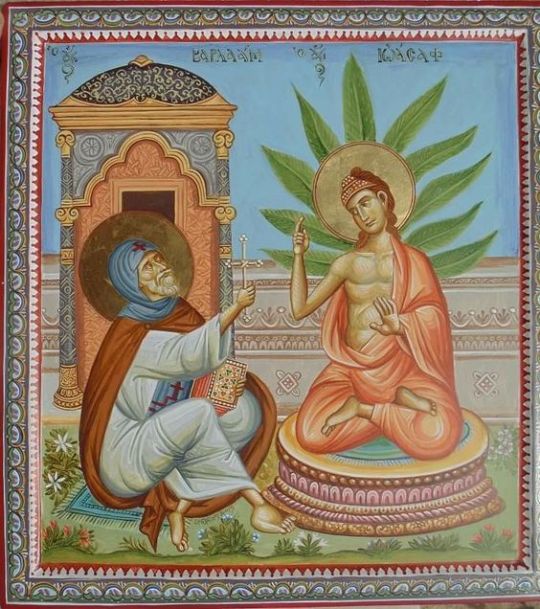
The Buddha in Christianity.
Called St. Josaphat (Budhasaf) of India, The story of St. Josaphat tells of a prince in India who is converted to Christianity by a monk, despite his father's attempts to prevent it. The monk and prince are later honored as saints in Christendom. The Buddha was honored as a Christian saint for about a thousand years, but this wasn't recognized until the mid 19th century.
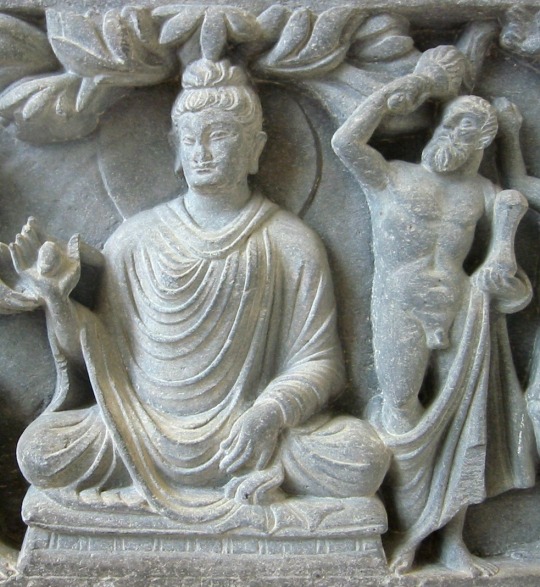
The Buddha in Hellenism.
Buddhism had a big influence on ancient Greeks, in which they would identify Buddhist beings with Greek beings, the Greeks were also the first ones to make Buddhist statues. Heracules (or Zeus) was identified with The bodhisattva Vajrapani, whom was seen as Buddha’s protector. There also was a Syncretism between The Buddhist Goddess Hariti & Greek goddess tykhe.

The Buddha in Taoism.
Some Taoist believe that the Buddha was a reincarnation of Laozi, the founder of Taoism. Some also believe he was either on the same power-level as the Jade emperor, the Taoist king of heaven, or stronger than him. 'Buddha' is absorbed wholly into the Taoist cosmology, becoming another term used to describe the generative tissue at the source of all things in both the mental and physical realms.
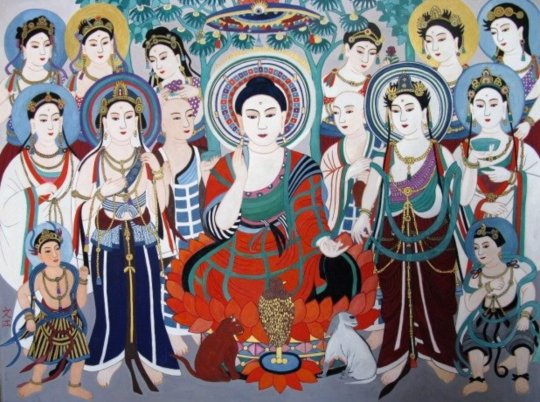
The Buddha in Shinto.
Buddhism & Shinto are mostly seen highly entwined in Japan. The buddha is called Shaka in Japanese & was transformed into a powerful Japanese deity, whom coexisted with the Shinto gods. Buddhist temples were often attached to Shinto shrines. A Shinto temple would sometimes have a priest of that shrine read a Buddhist sutra in which Shinto events took place.
#buddhism#buddha#buddhist art#hinduism#christianity#hellenism#Taoism#daoism#shinto#shintoism#religions#the buddha#Siddhartha#gautama#siddhartha gautama#shakyamuni buddha#shakyamuni#desiblr#lotus-list#buddhistwitch#desi#desi tag#mahayana#vajrayana#theravada#zen
18 notes
·
View notes
Text
Nezha Reborn annotations - Part 2
Part 1|Part 3
Monkey asks Yunxiang whether his dad ever told him the story of Nezha conquering the dragon king when he was a kid. Most Chinese people will probably remember this story from the 1979 animation of the same title that was adapted from chapter 14 of Investiture of the Gods.
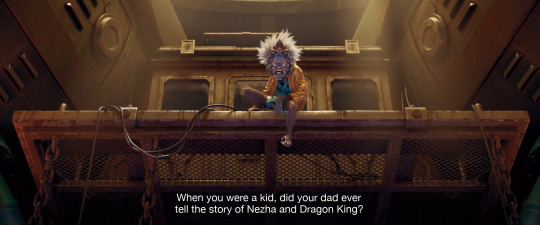
More product displacement: Smirnoff, what looks to be Suntory Royal and if you zoom in on the Jack Daniels, it reads “Made in Light Chaser” lol

Primordial Spirit or “god-body” is something you’ll see a lot in the New Gods universe. Known in Chinese as yuanshen (元神), it is a concept in Daoism defined to be a level of existence surpassing that of physical existence, capable of existing independently in the form of a soul. It is viewed to be the center and essence of a human's existence.

Monkey breaks the fourth wall
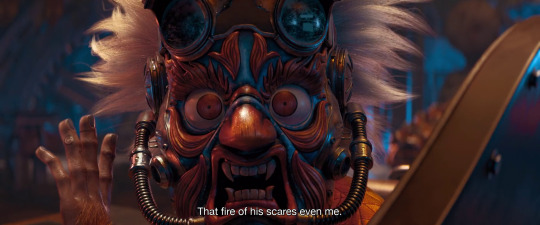
This quote comes from Liu An’s poem Nüwa mending the heavens (女娲补天), delivered Peking Opera style, down to the mannerisms. The caged bird could be a thrush or a lark. Bird keeping is a traditional hobby in Beijing that started in the Qing Dynasty and songbirds were usually kept in these cylindrical cages.
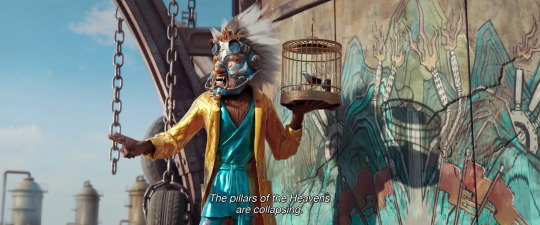
I shouldn’t have laughed so hard when he accidentally killed the glasses monkey and continued his business like nothing happened.

“Fire imp” (葫芦老四) is the fourth of the seven Calabash Brothers, a classic Chinese cartoon from the 80s. Each bro has a unique power, and bro #4’s power is the ability to control fire. The snake demoness is an integral part of that story, so Light Chaser’s White Snake movies might actually be set in the same universe?????

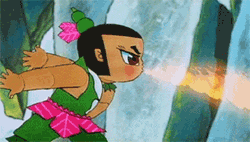
Chan and Jie are religions featured in IOTG. Chan Daoism was founded by Yuanshi Tianzun (Primeval Lord of Heaven) and Laozi, and Yang Jian is one of its disciples. Jie is a fictional religion headed by Tongtian.

The most unfortunate character in this movie has got to be this monkey.
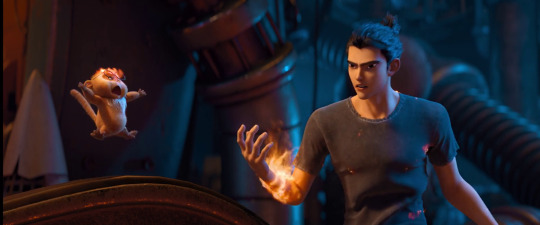
“Are your training methods even legit?”

Where did he get so much water? I thought water was being sanctioned.

RIP this monkey again.
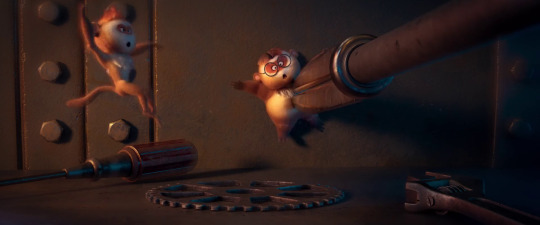
He built his own version of Nezha’s spear.
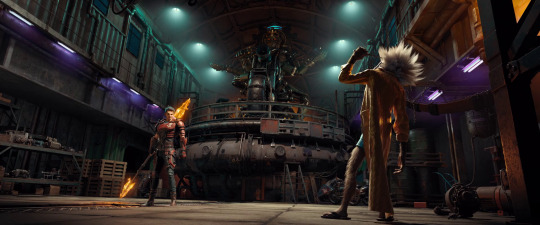
The Six-Eared Macaque is arguably the most dangerous antagonist in Journey to the West. This deceptive creature impersonated Sun Wukong after the Monkey King abandoned his pilgrimage following a tiff with Tripitaka, with the impersonation so perfect, only Gautama Buddha and Diting could see through the pretense.

Nezha’s primordial spirit manifests as his three-headed, six-armed form.

Nezha is traditionally depicted with his four Astras - the Wind Fire Wheels (风火轮) under his feet, the Cosmic Ring (乾坤圈) around his body, the Sky Ribbon (浑天绫) around his shoulders and a Fire-tipped Spear (火尖枪) in his right hand.

This man has gills.
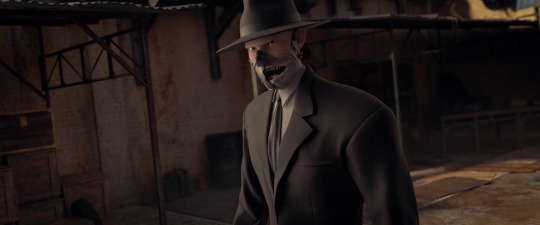
The Yaksa Li Gen is described as a lizard like creature with long mercury red hair, protruding fangs, and a face the color of indigo. (IOTG chapter 12).

Netflix's thirst trap of a thumbnail is from a scene that lasted ONE WHOLE SECOND.
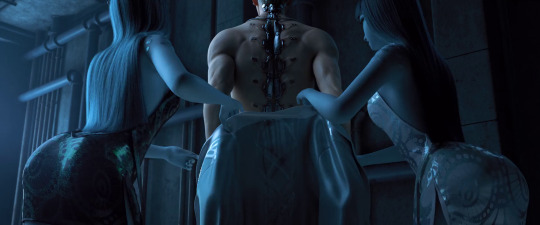
It’s hilarious how this guy was just credited as “the traitor”.
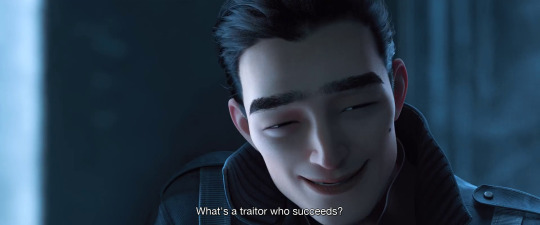
The art deco style of the crystal palace 👌


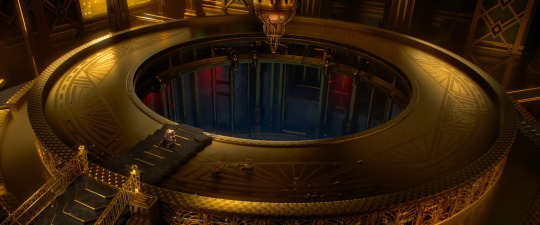

In 2013, archaeologists unearthed a 1000 year old statue in Sichuan in that depicted a beast resembling a rhinoceros. This was believed to be the water-suppressing mythological beast Zhenshui Shenshou (镇水神兽) that was documented in the Biography of Shu Kings Written by Yang Xiong in Han Dynasty.

“I taught him? I don’t even have disciples! Stop joking.”

Dragons kind of have a low status in heaven (no matter how majestic they are, they are still beasts and all beasts are looked down upon by the gods), unlike in the mortal realm where they are revered.
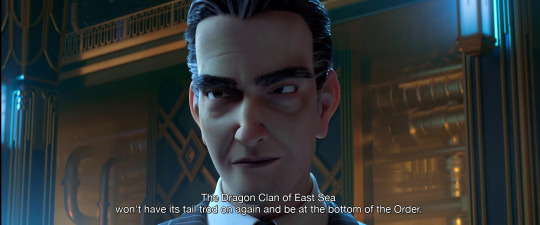
Even in his dragon form, Ao Bing’s spinal column is supported by metal bracing.

Part 1|Part 3
194 notes
·
View notes
Text
Buddha Photorealistic PBR Low-poly 3D model
#sculpture#statue#art#museum#religion#architecture#figure#ancient#buddha#sale#gautama#mystic#spiritual#scanned#room#people#god#monument#character#man
0 notes
Text
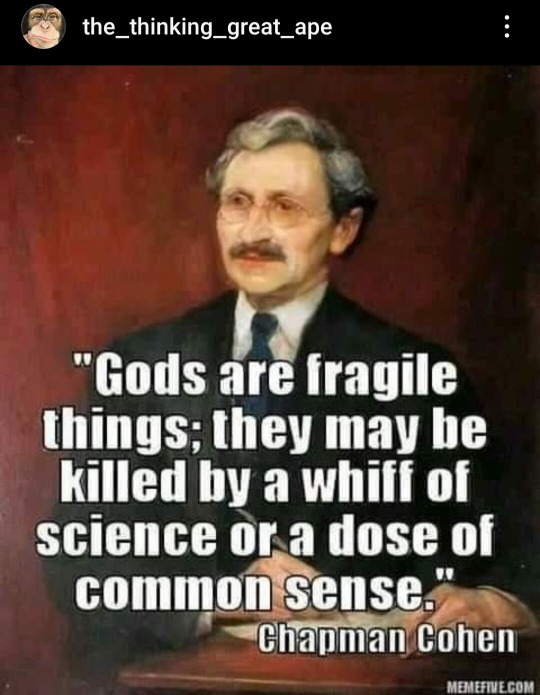
This is True. However, the definition of "god" is so exclusive and otherwise isolated in ALL Western religions. Long ago, the Hindus..specifically the Rishis taught as did Siddhartha Gautama-the Buddha that "god" is not a being. It is a consciousness that is the Universe in its entirety. We need not worship, sacrifice animals or humans, to it nor build temples (unless on a path to enlightenment as a monk) and shrines with statues and images to supposedly reflect its existence. WE are its existence. Put another way, by the Yogi Patanjali: "The Soul does not love, It is Love Itself. It does not exist, It is Existence Itself. It does not know, It is Knowledge Itself. How to know God". Also, in the multiple versions of the Bible, Jesus points to that in a different way telling his disciples and quoting from Psalm 82:6 "Isn't it written in your Law, 'I hath said ye are gods and all children of the Most high?" ..meaning that we are all born in the universe and are part of it and we are ALL gods and exist with divine consciousness within us. Jesus was a mystic not "the" son of God , but "a" son of God as we ALL are. BTW.. this is the reason he was supposedly murdered. Because the people at that time thought he meant he was the Only son of God and no one could say that without the threat of death because of Blasphemy. All of that part of the Bible is LOST on most Christians today, just as it was during Jesus' time. I recommend this page by Alan Watts as a better explanation than I have made here. It's on YouTube to listen to or the transcript can be read.
25 notes
·
View notes